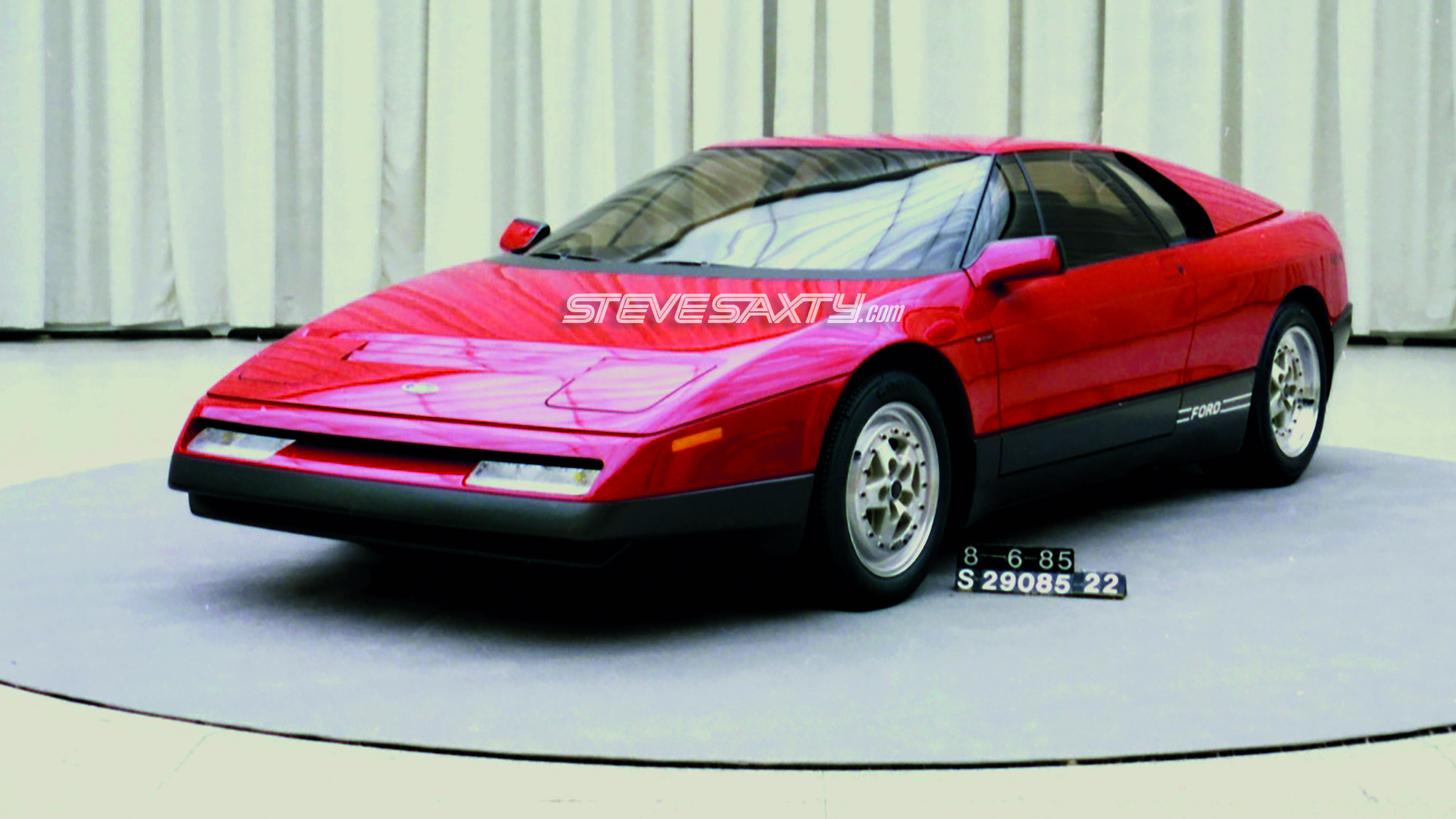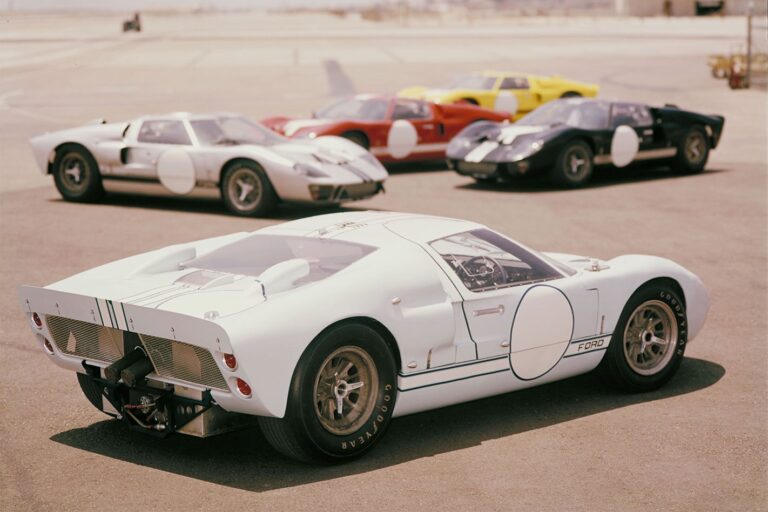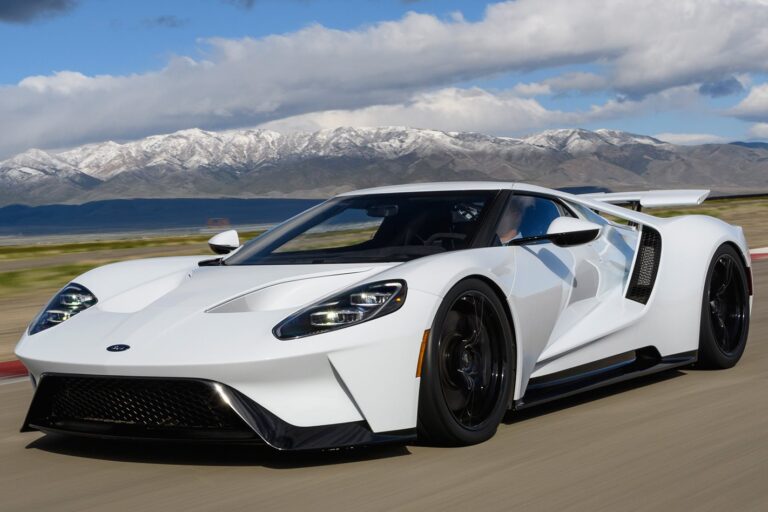It’s December 1988. You’re about to buy a Ferrari 328. You’ve had a 911 before, you’ve considered a Chevrolet Corvette for its macho looks and grunt, and a Porsche 944 Turbo, which handles better.
But what about this new mid-engined Ford, said to best every other sportscar, at any price?
It’s grippier than even a Testarossa or Countach and out-handles everything through a slalom – F1 champion Jackie Stewart helped develop it. And its Yamaha-Ford V6 sounds like a ripper. Not to mention everyday useability thanks to good vision, convenient access, a proper boot… and Ford-size bills. The Ghia-designed targa body looks the business, too; right up there with the Testarossa for a third of the price.
Too good to be true? Well, it came close to reality. Through the ’80s, a skunkworks team of Ford Special Vehicle Operations engineers conceived and developed a supercar called GN34. It would be the world’s best – styled in Italy, British-designed chassis, SVO engineering, quad-cam Japanese V6 power, state-of-the-art assembly in Europe, and all aimed at beating Porsche and Ferrari.

Down the years, rumours and snippets about the car have sprinkled the web but the facts have been secret until now. Now, freshly uncovered information, specifications and photographs show how serious Ford was and what an impact GN34 could have had.
Its existence was unearthed by author Steve Saxty while he was researching his new book Secret Fords Volume Two, published this week. Bit by bit, as former Ford designer Steve traced and talked to GN34’s creators, the car’s story emerged. Engineers handed over photographs kept private for decades; a Ford archivist discovered a cache of GN34 material in Detroit; and Steve ferreted out more in the archive of Ghia, the Ford-owned Italian studio where the car was designed.
In the early ’80s, Ford analysts predicted that sales in the so-called G-class – dedicated sportscars – would jump from 88,000 to 120,000 a year by 1990 in the USA alone. Sector entrants ran from the US$15,000 Toyota MR2 to the US$70,000 Ferrari Testarossa but the biggest volume and profit was around the US$30,000 mark (US$70,000 in today’s money) dominated by the Chevrolet Corvette and Porsche 944. Time for Ford to play, too.

In October ’83 Ford Special Vehicle Operations, led by ace motorsport manager Mike Kranefuss, started thinking what a G-class Ford could be, and set its sights high. Ronald Muccioli, SVO’s Planning/Program Manager, told Saxty: “It was a once in a lifetime opportunity – build something to tackle Ferrari and sell it at a Corvette/Porsche 944 price.”
SVO posited that a US$170m investment could be returned four times over. Bigwigs listened and by early ’84 the project had an initial budget, a codename – GN34 – and a target to have prototypes running in ’86 for production in late ’88 as an ’89 model.
The SVO engineers insisted that the car should be mid-engined. The 944 and Corvette were front-engined but rivals with the more premium cachet and sleeker profile that SVO wanted were mid-engined. It seemed a no-brainer but Muccioli’s team had to repel two front-engined coupe counter-proposals based on the Sierra that would have cost less before GN34 development got the green light.

Body design kicked off early in 1984 when Ron and three colleagues flew to Turin to see Giorgetto Giugiaro at Italdesign. Guess what: the Italian design and engineering outfit was already building a concept called Maya that matched Ford’s desires. Contracts were swiftly signed, SVO sent over a Taurus 3.0-litre V6 powertrain and when Maya appeared at the Turin show in November ’84 it was a Ford-powered runner.
But Maya looked too much like the Lotus Etna that Italdesign had offered Lotus as an Esprit replacement. Ford asked Giugiaro to (a) make it look different and (b) viable for production. Italdesign responded with two cars: styling model Maya II ES and Maya II EM, a mechanical prototype for evaluation and development.
Ford’s own designers were hardly going to be trumped by an outside supplier. The Ford International Studio in Detroit and Ghia in Turin raced to pitch in their designs. In August 1985 the three rival models, all painted red, were arrayed for a beauty parade in Detroit.

Maya II bit the dust and the Ford International and Ghia models – one tougher-looking than the Ital car, the other with leaner surfaces and better vision – went to California to be scrutinised by potential buyers. Lined up against a Nissan 300ZX, Porsche 944 and 928, Corvette and Ferrari 308, the Ghia GN34 won. Even when told it was a Ford, clinic guests still preferred it to the Ferrari. They valued it at $38,000 against Ford’s intended price of $26,500.
Ford Design in Detroit refined the Ghia GN34’s surfaces, making it leaner, longer and more practical. Now its larger targa roof could stow above the engine and briefcases would fit behind the seats. The shape – “clean and functional, rather than trendy, to embody the timelessness of the Porsche 911 and Ferrari” according to an internal description – was ready for sign-off.
The same project summary for the board from the GN34 Program Office in July 1986 said the interior packaging and ergonomics would be best-in-class for a mid-engined car, with exceptional functionality and refinement. Build quality would be ensured by a state-of-the-art assembly system being installed at French contractor Chausson.

Meanwhile, Maya II hadn’t disappeared. In September ’85 Italdesign shipped over the Maya II EM mule, built to approximate how GN34 would drive. The Yamaha V6 that Ford had commissioned for the 1989 Taurus SHO wasn’t ready so the mule used a twin-turbo Ford V6 and ZF five-speed gearbox.
The extra weight from the design changes forced Yamaha to enlarge the high-revving V6 from 3.0 litres to 3.6L and lift its power from 170kW to 209kW. It would mate with a close-ratio five-speed transaxle. Later, SVO planned to add Ford’s new 4.6-litre modular DOHC V8 engine and all-wheel drive. The engineers didn’t want to launch with a Ford V8 because it was “too Corvette” for buyers used to Porsche and Ferrari engines.
SVO’s GN34 team – now swelled from 30 to 100 – worked to an eight-point plan covering the reasons buyers bought sportscars. ‘Fun-to-drive’ topped the list. When SVO measured rivals’ lateral acceleration they found the Corvette, with 0.89g, was grippiest, followed by the Countach with .87, Testarossa .86 and the 944 Turbo and RX7 Turbo equal with .85, while the Ferrari 328 pulled .84.

So SVO set GN34’s target at .95 to 1.0g. Through Ford’s slalom, the RX7 was fastest, followed by the 944 Turbo, Countach, Turbo Esprit, 911, ’Vette and Supra, with the Testarossa and newly arrived 328 eighth. Again, they decreed that GN34 had to outhandle the lot.
To do that, the chassis design engineers Ford chose – Canewdon Consultants in Essex, England – gave GN34 an unrivalled spec for the time: forged aluminium unequal-length upper and lower wishbones at the front plus a Quadralink rear with twin lower arms and a tension strut from SVO’s race cars. Cockpit-adjustable hydraulics varied the ride from “very low-frequency plush to a firmer highly damped Corvette-like setting” according to a document Saxty found.
The power-assisted variable-ratio rack and pinion steering’s feel adjusted with the changes in cabin-dialled damper settings. Disc brakes with ABS and four-piston aluminium calipers sat inside 17-inch wheels with 40-aspect tyres. Noise, vibration and harshness targets would be class-best.

Formula 1 champion Jackie Stewart first drove the Maya II mule in autumn 1985 and confirmed the car’s potential. Ron Muccioli told Saxty that even at that stage “the mule had a flat and measured ride and took the handling track’s corners as well as any competitor. We all felt we could meet or exceed all the best-in-class targets.”
Ford built another mule and high-performance contractor Roush Engineering (where Muccioli would later work) made two more, one with a V6 and one with a Windsor V8, using a GN34 chassis beneath modified De Tomaso Pantera bodies – both survive in Roush’s museum. All told, there were four running mules and four fibreglass or clay body models.
So, with all its potential, why wasn’t GN34 launched? Ironically, it was killed by ‘Maximum Bob’ Lutz, one of Ford’s biggest car enthusiasts. After heading Ford of Europe in the early ’80s, Lutz ran Ford’s truck division in Detroit. And during an investment meeting on 16 July 1986, Lutz pitched a new thing called a Sports Utility Vehicle against GN34.

The board had to choose: did it invest in a new type of 4×4 that might appeal to hundreds of thousands of buyers? Or a halo supercar for just 20,000? The SUV got the nod and on 27 August 1986, the GN34 program was cancelled.
All work stopped immediately and the files were locked away until unearthed by Steve Saxty this year. Saxty concludes: “When Honda launched the NSX in 1990 it shocked Ferrari to its core. Here was a mid-engine car from a mass manufacturer that bested the new Ferrari 348 dynamically while being as easy to use as a Porsche. The equally advanced and striking Ford GN34 could have been up there with the greats.” The data and photos in his book tell a fascinating story of a car that many at Ford still wish had been built.
Secret Fords Volume Two by Steve Saxty is available in standard and collectors editions directly from stevesaxty.com.







